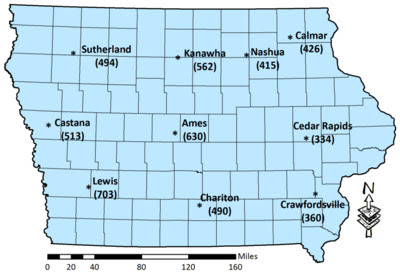In May, reports from around the state have indicated leafhoppers are rising in numbers. The species we are most familiar with in Iowa is potato leafhopper. They are small, bright green and have white eyes. Note the spiny legs and clear wings that extend well past the end of the abdomen. Treatment thresholds for alfalfa can be found
here. Consider reducing this threshold for high-quality dairy hay.
Potato leafhopper adults are about 1/8 inches (3 mm) long. Photo by Marlin E. Rice.
A few places in Iowa, Nebraska and the Dakotas have reported another species, aster leafhopper, in fields this year. They are a little bigger and have an olive green or brown body. Aster leafhoppers have a wide host range and are can be a pest of vegetables, field crops, and ornamentals. A treatment threshold for alfalfa and other field crops isn't well defined. That is partly because they can vector a plant disease called aster yellows. Cost-effective treatment decisions would be dependant on disease severity in combination with leafhopper density. Aster yellows has similar visual symptoms to barley yellow dwarf virus in small grains. So consider an insecticide application when symptoms first appear (e.g., yellow or mottled leaves) or if clouds of leafhoppers are disturbed when walking through fields. Pyrethroids are generally effective but may need to be reapplied if migratory populations reinfest fields.

Aster leafhopper are about 5/32 inches (4 mm) long and have a wedge-like body. Photo by Whitney Cranshaw, www.ipmimages.org.








